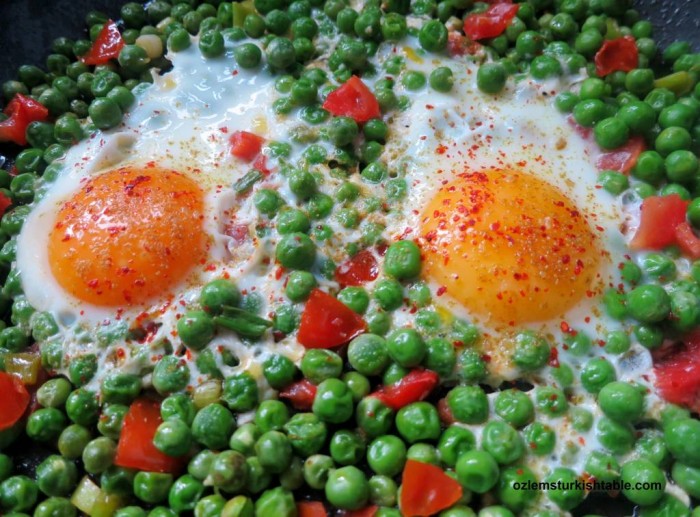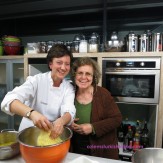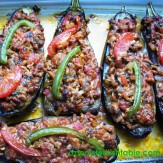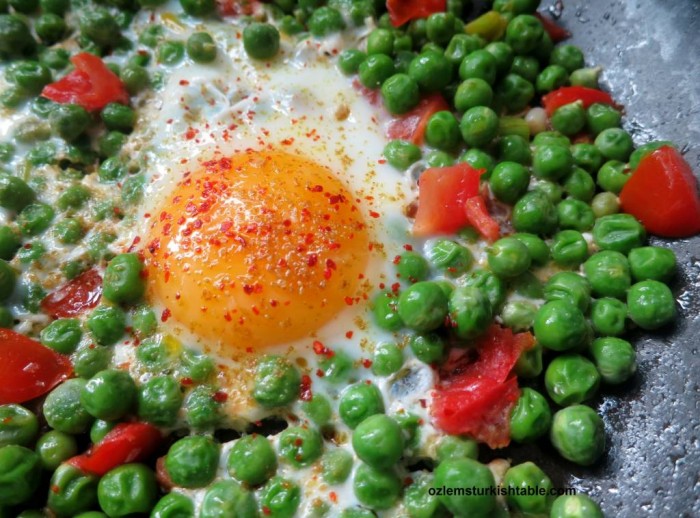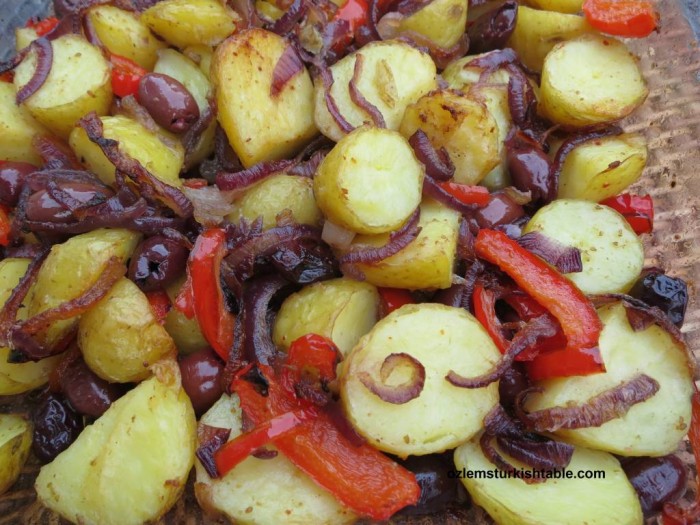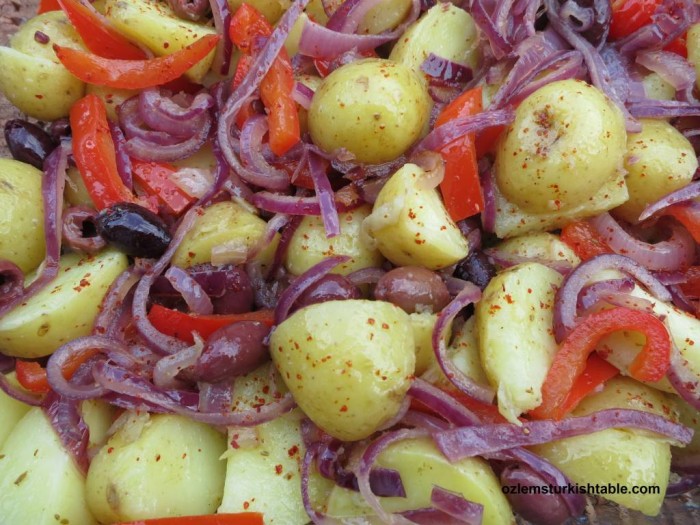Have you ever tried hummus warmed up? In Turkey, especially in the South, hummus is served warm with sautéed Turkish sucuk (sausage) – or pastirma (pastrami) or with sautéed pine nuts over the top. I strongly suggest you to try hummus this way, as I feel you may be pleasantly surprised and maybe converted to eat hummus warm as many of my friends have done.
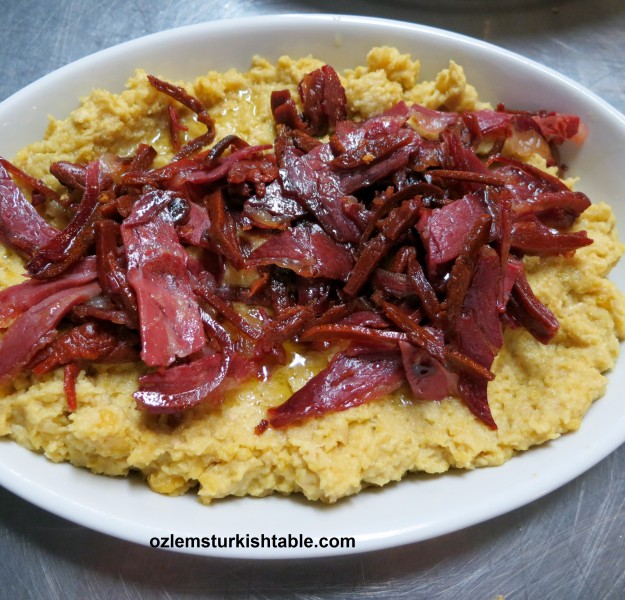
Warm hummus with sauteed Pastrami (Pastirma, Turkish dried cured beef) – the flavors complement each other so beautifully.
Please adjust the recipe according to your taste, as some like it garlicky, some with more tahini and others may prefer it more lemony. In my recent Turkish cooking class, I added the sautéed pastrami, pastirma, over warm hummus, as it is served in traditional kebab houses in Turkey. Pastirma is a dried cured beef coated with spices and has a delicious, rich flavor. The hummus and the spice coated pastrami has complemented each other so beautifully here. If you can’t get Turkish pastrami, you can use the Italian pastrami or your favorite cured meat or grilled meat.
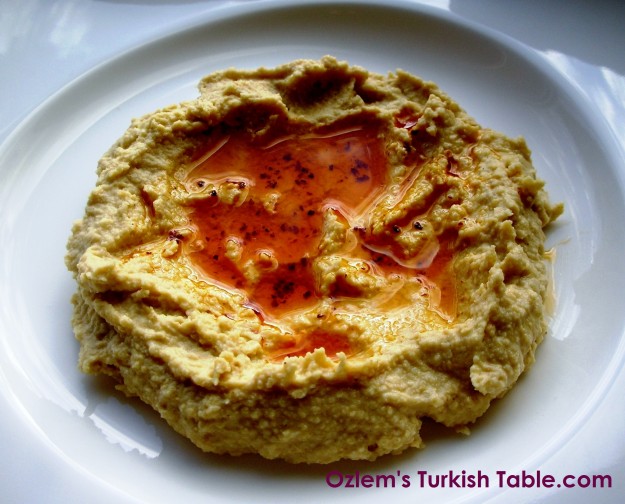
Warm hummus with red pepper flakes infused olive oil – a delicious vegetarian dip.
This warm hummus would make a wonderful appetizer to share with friends and family and goes so well with grilled vegetables or meat by the side. For a vegetarian option, you can serve the warm hummus with red pepper flakes infused olive oil, this one is so delicious too. Both these options may also be wonderful addition for the Mother’s Day spread, if you are celebrating. Pita bread is the perfect accompaniment – hope you enjoy it.
Serves 4-6
Preparation time – 15 minutes (add 1 hour if used dried chickpeas and soaking overnight)
225gr/8oz dried chickpeas or garbanzo beans, soaked in water overnight or for at least 6 hours or equivalent amount of precooked chickpeas in can
5ml /1 teaspoon salt – please adjust according to your taste-
60ml/4 tablespoons extra virgin olive oil
30ml/2 tablespoons water
2 garlic cloves, crushed – optional-
Juice of 1 lemon
30ml/2 tablespoon tahini (sesame paste)
5ml/1 teaspoon ground cumin
To serve:
30ml/2 tablespoons olive oil
1/2 teaspoon red pepper flakes
1/2 teaspoon ground cumin
110gr/4oz Turkish Pastirma, chopped in 1″ strips (or your choice of any Pastrami or sausage)
Slices of pita bread to serve
If using dried chickpeas (garbanzo beans), drain the chickpeas and transfer them to a pan with plenty of cold water. Bring to boil and boil for a few minutes. Then lower the heat and partially cover the pan, Simmer the chickpeas for 1 hour, until they are soft and easy to mash.
If precooked chickpeas are used, drain the juice and give them a little wash in a colander. Put the precooked (or cooked) chickpeas in a food processor and blitz them together with the extra virgin olive oil, water, lemon juice, garlic and tahini. If it appears thick and difficult to blend, add a little more olive oil or water. Season with salt and mix in the cumin and red pepper flakes (if desired). Process until you achieve a soft, smooth paste. Refrigerate until required.
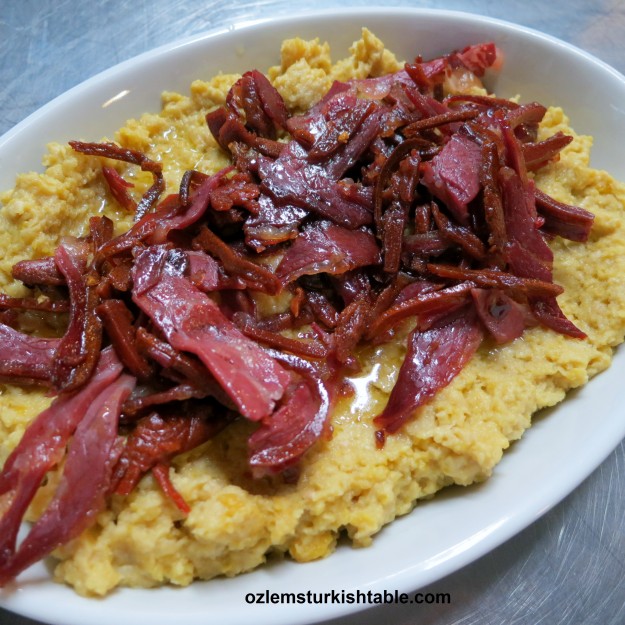
Warm hummus with sauteed pastrami; makes a delicious appetizer and goes well with grilled vegetables and meat.
Just before serving, add a splash of olive oil and heat the hummus in a pan for a couple of minutes. In a separate pan, sauté the strips of pastrami in olive oil. Place the warm hummus in a plate with the sautéed meat over the top, scattering some ground cumin and red pepper flakes over. Serve immediately with slices of pita or flat bread by the side.
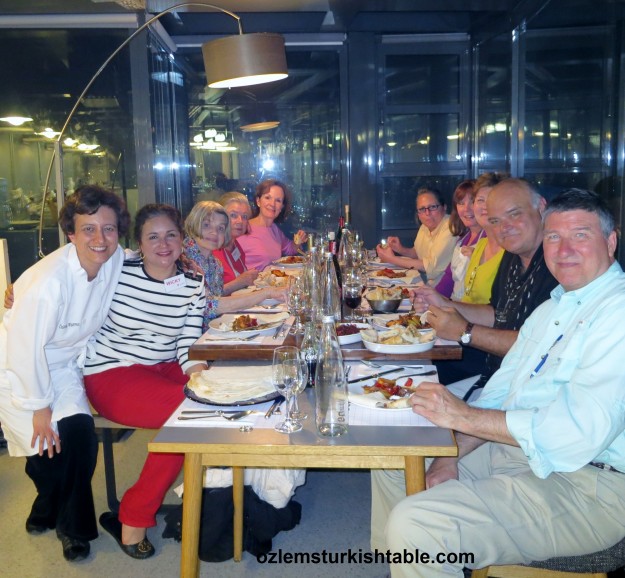
We all enjoyed the warm hummus as part of our Turkish cookery class at the Istanbul Culinary Institute.
Afiyet Olsun,
Ozlem
Strolling Through the Battlefields of Gallipoli – Dardanelles
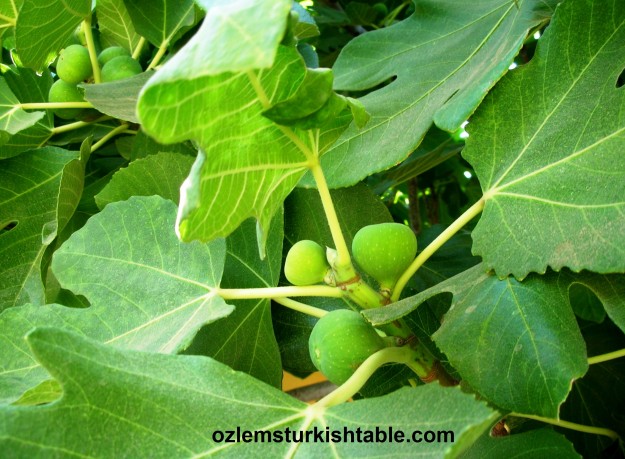
Driving towards Canakkale, we saw bountiful fig trees, just beautiful.
Our culinary and cultural tour to Turkey has almost come to an end; going to Gallipoli and visiting the battlefields near the Dardanelles has been a highlight to many folks and did provide a reflective, emotional moment.

Ferry trip from Canakkale to Gallipoli, Gelibolu.
Gallipoli, Gelibolu is a peninsula in North-west Turkey, close to Istanbul. The Gallipoli Peninsula is the site of extensive First World War battlefields and memorials on the north bank of the Dardanelles Strait. You can take the ferry from Canakkale to go to Gallipoli like we did, it is easy and convenient.
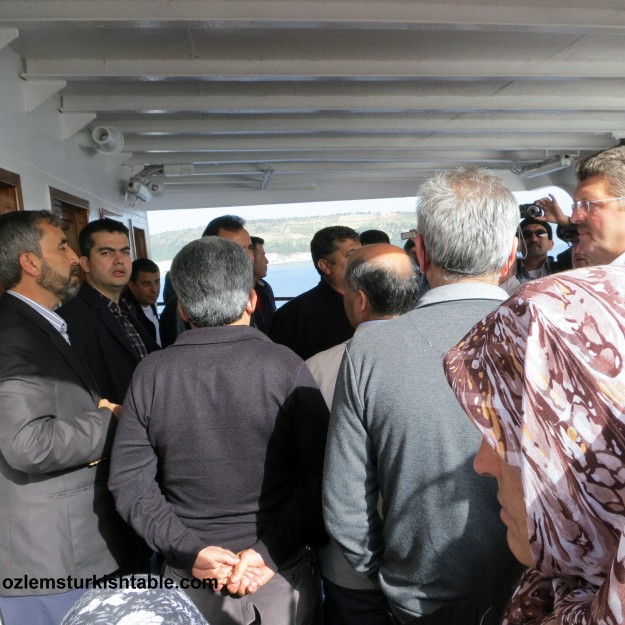
A surprising and emotional moment, hearing the locals singing Gallipoli folk songs at the ferry.
While on the ferry, all of a sudden we saw a group of locals gathered at the deck, singing Canakkale Turkusu, Gallipoli Folk Song whole heartedly. I remembered singing this folk song as a child, it was a surreal and an emotional moment, we all joined in.

The impressive Gallipoli Kabatepe Museum, well worth visiting
The impressive Gallipoli Kabatepe Museum (or Gallipoli War Museum) was recently opened and so well worth a visit. It has 11 gallery rooms, each equipped with advanced high-tech simulation equipment and the technology allows visitors to choose their presentation language and interact with the display. The centre houses an extensive collection of historic items relating to the renowned World War I campaign and we have been told that the simulations are so real.
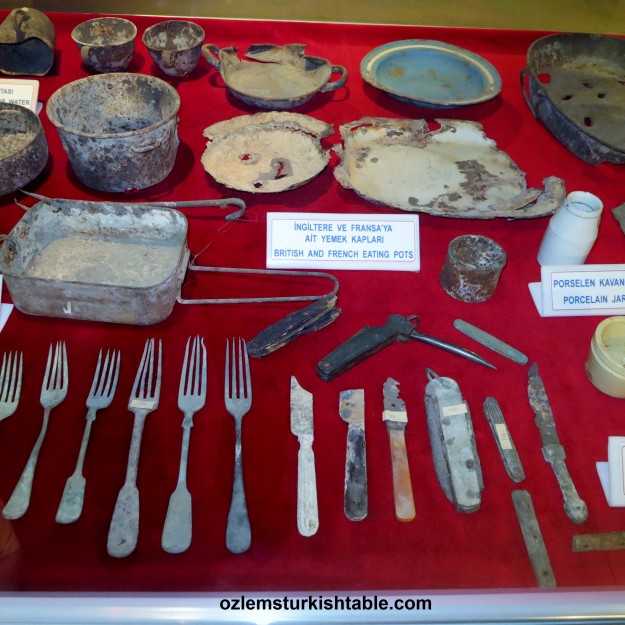
Private belongings of the soldiers neatly preserved and displayed at the Gallipoli Kabatepe (War) Museum
Gallipoli Kabatepe Museum hosts numerous relics from the campaign including weapons, uniforms, ammunition, letters written by soldiers to their families, photographs, and private belongings such as shaving tools, cocoa tins and cutlery. A very poignant and emotional moment to view and get so near to each piece.
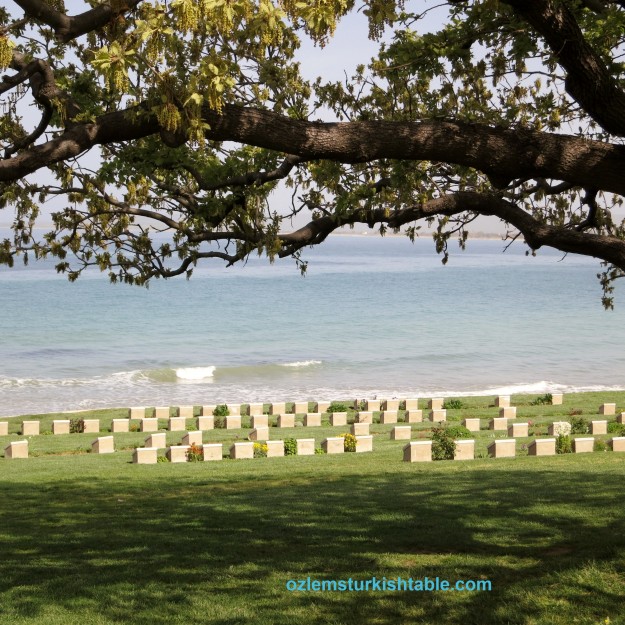
Ariburnu Cemetery at Ariburnu Beach, Gallipoli
We then drove up to the Ariburnu Cemetery, at the beautiful Ariburnu Beach. The Ariburnu Cemetery is situated on the north edge of ANZAC Cove by the shore where the Anzacs first landed on 25 April 1915. We were told that 253 Allied soldiers rest in the cemetery; it was very emotional visiting the graves. It is such a peaceful spot and may all those souls rest in peace.

The Ariburnu Memorial, Ataturk’s wonderful epitaph is a stone monolith beside the Ariburnu Cemetery
Mustafa Kemal Ataturk, the extraordinary leader and founder of today’s Turkey, wrote a tribute to the ANZACs who lost their lives at Gallipoli. This wonderful tribute inscribed in English on the monolith are the famous words Mustafa Kemal Ataturk delivered in 1934 to the first Australians, New Zealanders and the British to visit the Gallipoli battlefields. I absolutely loved and embraced it:
Those heroes that shed their blood
And lost their lives…
You are now lying in the soil of a friendly Country.
Therefore rest in peace.
There is no difference between the Johnnies
And the Mehmets to us where they lie side by side
Here in this country of ours…
You, the mothers,
Who sent their sons front far away countries
Wipe away your tears,
Your sons are now lying in our bosom
And are in peace
After having lost their lives on this land
They have become our sons as well
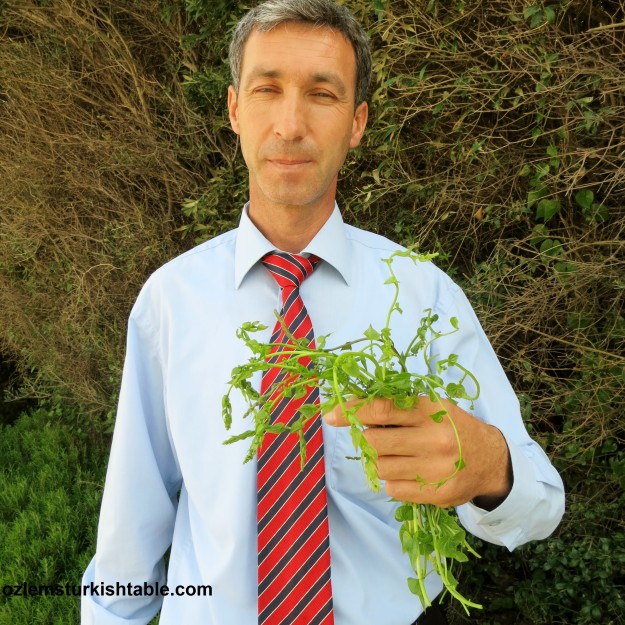
Our dear driver with his favorite greens, Sarmasik, Wild Ivy hand picked in Gallipoli
Just as we have been reflecting on what we’ve seen on Ariburnu Cemetery, our dear driver, Mehmet Bey excited came forward to show the wild greens he just picked up by the side road’ “Ozlem Hanim” he said “ these are the best Sarmasik (Wild Ivy) you can get. I will sauté with garlic and crack my eggs into it tonight, delicious!” Being from the Aegean region, I know how much Mehmet Bey loves the fresh, wild greens – food managed to bring similes to face again.
And off we set towards Istanbul, looking forward to the buzz of the city and that baklava class..
